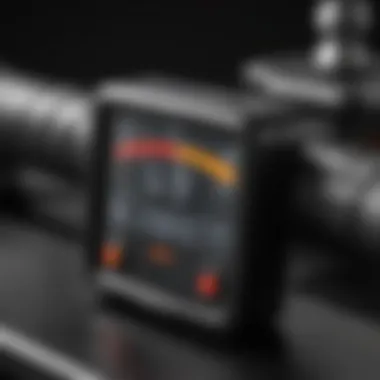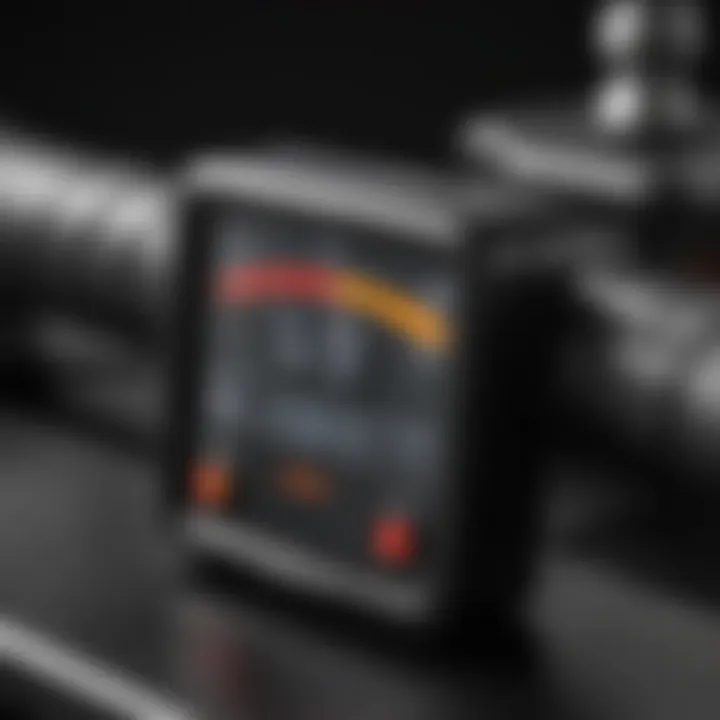Measuring Grip Strength: Essential Tools and Insights


Intro
Grip strength is more than just a test of brute force; it's a window into one's overall muscular health and physical fitness. Why does grip strength matter? As it turns out, the strength of our grip is a strong indicator of our body's performance, affecting everything from daily tasks to athletic capabilities. In this article, readers will embark on a thorough exploration of the tools and devices used to assess grip strength. Whether one is a competitive athlete, a rehabilitation professional, or just someone looking to gauge their fitness level, understanding grip strength measurement tools is essential.
By examining various devices, their mechanisms, applications, and the contexts in which they thrive, this piece aims to shed light on the significance of grip strength assessment. The goal here is not merely to provide a rundown of popular tools, but instead, to offer a rich narrative that enhances comprehension of grip strength's importance in diverse fields, such as sports science, physiotherapy, and elderly care.
Understanding Grip Strength
In diving into the world of grip strength, we open a door to a domain that often gets overlooked but is so vital, especially in fields like health, fitness, and rehabilitation. Grip strength, in its essence, isn't just about how tightly you can hold onto something; it serves as a window into our overall muscular health and functionality. Particularly in clinical settings, measuring an individual's grip strength can reveal a lot—whether a patient is recovering from an injury or if muscle degeneration is setting in due to aging.
The benefits of understanding grip strength are manifold. For one, it can serve as an early indicator of more serious health issues. Research shows us that diminished grip strength correlates with conditions like cardiovascular disease or even cognitive decline. Therefore, keeping tabs on this strength can lead to timely interventions, potentially preventing worsening health outcomes.
Moreover, grip strength isn't solely a measure for the elderly or those undergoing rehabilitation. Athletes use grip strength as a benchmark of their performance and readiness. Whether you’re swinging a bat or throwing a javelin, a solid grip can make all the difference. Hence, developing a nuanced understanding of grip strength enriches various areas, from clinical analysis to sports science.
Defining Grip Strength
Grip strength can be defined as the force applied by the hand to grasp or hold an object. This metric is not merely one-dimensional; it encompasses various aspects of strength, including pinch grip, crush grip, and support grip. Each of these types plays a unique role in evaluating one's dexterity and hand function.
- Pinch Grip: Involves holding objects between the fingers (think pinching a coin).
- Crush Grip: Characterizes the act of squeezing—like pressing a stress ball.
- Support Grip: Refers to holding onto something for an extended period, such as carrying a suitcase.
Understanding the nuances here is essential, especially when selecting appropriate measurement tools. Each type of grip can be indicative of different underlying strengths and should be assessed based on the specific needs of the individual.
Clinical Significance
From a clinical perspective, grip strength serves as a valuable diagnostic tool. Many healthcare professionals consider it a key indicator of overall health. An objective measure of health is indispensable, as it offers insight into a person's functional capacity. For instance:
- Rehabilitation: Patients recovering from surgeries often show significant improvement once they start regaining grip strength. It’s a measure that can clearly indicate rehabilitation progress.
- Aging: In older adults, a decline in grip strength can signify increasing frailty, which can guide preventive interventions.
Research has established clear connections between low grip strength and higher mortality rates, underscoring its importance in clinical assessments. Hence, the value of grip strength goes beyond just muscle fitness; it has profound implications for overall well-being.
Impact on Athletic Performance
For athletes, measuring grip strength is equally significant, albeit from a performance enhancement angle. Whether it’s rock climbing where grip strength could mean the difference between the summit and a fall, or a powerlifter needing a firm hold on the barbell, grip strength plays a critical role in numerous sports.
- Injury Prevention: A strong grip can help prevent injuries. Athletes with better grip strength often show enhanced stability in their overall performance.
- Power Transfer: A robust grip allows effective power transfer throughout the body. When the grip is strong, athletes can better connect their lower body strength to movements executed by the upper body.
Every aspect of athletic performance goes hand-in-hand with grip strength. It often acts as a foundation upon which other skills can be built.
"Strong hands, strong life! Grip strength is where it all begins."
Types of Grip Strength Measurement Tools
Understanding grip strength measurement tools is critical as it connects various fields such as health, sports, and rehabilitation. These tools not only aid in identifying muscle strength but also serve as indicators of overall physical health and functional ability. When someone mentions grip strength, they evoke images of athletes or elderly individuals trying to improve their strength; however, the tools used for measurement serve diverse purposes, providing insights that help professionals across varied disciplines evaluate and enhance performance or recovery.
Dynamometers
Dynamometers stand as the quintessential devices for measuring grip strength. Their design typically incorporates an adjustable handle that the user squeezes, providing real-time data about their muscular force. For clinicians and sports professionals alike, these measurements are important.
One of the most striking aspects of dynamometers is their versatility. They can be used in both clinical environments to measure rehabilitation progress or in athletic settings to assess performance during training.
"Dynamometers ensure accuracy that can’t be ignored, especially when it comes to tracking progress over time."
When looking at various types, handheld dynamometers are favored for their portability without sacrificing reliability. In contrast, larger clinical models might offer advanced features but could be cumbersome in setting up. Thus, choosing the right kind can heavily influence the results gathered in studies or assessments.
Hand Grippers
Hand grippers, while simplistic in appearance, offer valuable insights into grip strength as well. These tools require the user to squeeze two handles together, effectively offering an immediate sense of effort exerted.
They're particularly useful for anyone looking to improve their grip strength in a more individualized, portable manner. Athletes often use hand grippers as part of their training regimen to enhance hand endurance and strength. Furthermore, they can serve as excellent tools for rehabilitation, promoting engagement during recovery exercises.
While they lack the digital displays found in more advanced products, their simplicity can be appealing. However, it's important to consider if hand grippers provide the same level of detailed feedback that dynamometers do, as they often don’t retain quantitative data over time.


Digital Grip Strength Meters
Digital grip strength meters integrate technology to give instant feedback on muscle power. Many models come with LCD screens that display the force exerted in pounds or kilograms, making them user-friendly and easily interpretable for those who might not have a background in strength training.
The digital aspect elevates the experience because they often include capabilities like data storage, allowing users to track changes long-term. This feature is invaluable in clinical settings, where monitoring ongoing progress in rehabilitation can significantly impact treatment plans. Building reports from this data might make easier assessments for future training goals.
Mechanical vs Digital Devices
When weighing mechanical tools against digital devices, a few considerations come into play. Mechanical devices, like traditional hand dynamometers, provide a direct, analog reading of your efforts. The feedback may seem straightforward, but it doesn’t include the benefits of data tracking and user interfaces seen in digital devices.
On the other hand, digital devices boast functionalities that enable more precise and informed assessments over time. These gadgets usually come at a premium, but their sophisticated features might just be worth it, especially for professionals needing comprehensive data for rehabilitation or high-level sports.
- Mechanical Devices:
- Digital Devices:
- Simple to use
- No battery needed
- Usually more affordable
- Provide detailed digital feedback
- Track progress over time
- May offer Bluetooth connectivity for data transfer
Given the range of devices available, the choice between mechanical and digital often hinges on the specific needs of the user or the requirements of the environment in which they operate.
The Mechanisms Behind Measurement Tools
Understanding how grip strength measurement tools function is key to leveraging them effectively in various settings. Each tool comes with its specific design and mechanism, influencing both the measurement accuracy and usability. Since grip strength serves as a vital indicator across clinical, athletic, and general fitness domains, grasping the inner workings of these tools can enhance their application and interpretation of results.
How Dynamometers Work
Dynamometers are considered the gold standard for grip strength measurement. They operate based on the principle of force measurement, which translates the applied grip strength into a readable output.
- Mechanical Design: Most dynamometers consist of a handle that can be squeezed and a gauge that shows the grip force. Users grip the handle, and as they apply pressure, the mechanism inside measures the force exerted.
- Force Measurement: The device converts the applied force into a numerical reading, often displayed in kilograms or pounds. Most dynamometers allow for quick switching between units, accommodating diverse preferences and scientific standards.
- Calibration and Accuracy: Regular calibration is essential to ensure accuracy. A well-calibrated dynamometer can yield consistent results over time, essential for tracking progress in rehabilitation or performance settings.
This high level of precision is crucial because it allows for immediate comparison with normative data and can guide targeted interventions based on the results.
"Accurate measurements can make all the difference in tracking a patient’s recovery or an athlete’s performance."
Functional Principles of Hand Grippers
Hand grippers are another popular tool but operate differently compared to dynamometers.
- Design Variations: Hand grippers come in various designs, often featuring spring-loaded mechanisms. Users compress the handles, and the springs provide resistance, engaging the muscles and leading to strength development.
- User Feedback: Many hand grippers do not provide a direct numerical reading, but they can still be a useful gauge for personal training. By feeling the resistance, individuals can determine their strength levels over time.
- Progressive Resistance: Adjustable hand grippers offer a way to increase resistance progressively. This adaptability allows users to track improvement and challenge themselves continuously, leading to enhanced strength over time.
Understanding Digital Readouts
Digital grip strength meters represent a modern approach to measuring grip strength. They often combine traditional grip principles with technology to enhance both user experience and data interpretation.
- Real-Time Data: One of the standout features of digital meters is the immediate display of results on a screen. This instant feedback can motivate users and facilitate more accurate adjustments in training regimens.
- Memory Functions: Many digital tools include memory functions that enable users to store multiple readings, enabling better tracking of progress across sessions.
- Detailed Analytics: Some advanced models even analyze grip strength in terms of peak force and endurance. Such data can give invaluable insights into a individual's performance, guiding adjustments in training or rehabilitation programs.
In summary, understanding how various grip measurement tools function is crucial for anyone interested in assessing grip strength, whether for clinical purposes or athletic training. Each device has its strengths, limitations, and unique applications, making it essential to choose wisely based on specific needs.
Factors Affecting Grip Strength Measurements
The assessment of grip strength isn't just a matter of squeezing a tool and calling it a day; it’s a nuanced process influenced by various factors that can skew results if not carefully considered. Understanding these elements is crucial for accurate evaluations in clinical settings, sports performance assessments, and personal fitness tracking. When examining grip strength, one must appreciate that it doesn’t exist in a vacuum—numerous external and internal factors can sway measurements in significant ways.
Technique and Grip Positioning
In terms of grip strength measurement, the way an individual holds the instrument is paramount. A person can grasp the dynamometer or hand gripper as tightly as they want, but if their technique is off, the results could be misleading. The positioning of one’s hand, wrist angle, and even the seat’s height can play essential roles. For instance, gripping the device at an awkward angle can lead to suboptimal force generation.
It’s often recommended to keep the wrist straight and the elbow close to the body. Also, ensuring that the measurement is taken in a standardized position across all subjects will ensure more comparable results. Practices like these help eliminate variability in technique that could muddy the data.
Influence of Fatigue
Fatigue can sneak up on anyone and can significantly impact grip strength results. When measuring grip strength, the state of a person's muscles can affect their performance. A fresh athlete might exhibit a much stronger grip compared to the same athlete after a strenuous workout.
It’s common to take multiple readings and account for fatigue by instructing the participant to rest for a few minutes before measurement. This breaks the cycle of diminishing returns on strength output caused by muscle fatigue. Also, research shows that taking measurements in the morning, when muscles are least fatigued, may yield more reliable data.


Considerations for Age and Gender
It's well established that both age and gender can influence grip strength outcomes. Generally speaking, younger individuals tend to score higher than older adults due to age-related muscle loss or sarcopenia, while men often display greater grip strength than women of the same age.
When interpreting results, it's critical to use age norms and gender-specific benchmarks. For instance, a grip strength measurement from an elderly woman should be compared against norms established for her age group and gender rather than against a younger male's results. Recognizing these variations helps prevent bias in interpreting grip strength data.
In essence, being aware of these factors can pave the way for a more thoughtful interpretation of grip strength measurements, allowing practitioners, coaches, and health professionals to make informed decisions based on accurate readings.
Applications of Grip Strength Measurement
Grip strength measurement extends beyond the confines of gyms and rehabilitation centers; it's a multidimensional tool with wide-ranging applications that can influence several fields including health care, athletics, and fitness assessments. Anchoring its significance in different situations reflects the versatility and necessity of employing grip strength metrics.
Rehabilitation Settings
In rehabilitation environments, assessing grip strength is vital for tracking recovery progress. After injury or surgical procedures, patients often experience muscular weakness. Grip strength measurement tools help clinicians to evaluate these weaknesses objectively. A simple dynamometer can reveal how strength rebounds over time.
Utilizing grip strength assessments can lead to better-tailored rehabilitation protocols. For instance, a patient recovering from a wrist fracture may show different recovery rates based on grip measurements. Hence, understanding fluctuations in grip strength can guide individualized therapy plans to cater to unique needs.
"Strength assessment serves as a feedback loop between patients and their therapists, enabling informed adjustments to treatments."
This method is not just for limb injuries; stroke survivors also benefit greatly from such measurements. By employing grip strength tools, therapists can identify specific deficits, setting the groundwork for related exercises that build back those lost functionalities. With more focus on tailored rehabilitation, patients may find their recovery periods shortened and their quality of life substantially improved.
Sports and Performance Assessment
In competitive sports, grip strength is frequently overlooked, but it plays a crucial role in overall athletic performance. Athletes in sports such as golf, tennis, and climbing rely heavily on grip strength—mere seconds lost to a weak grip can mean the difference between winning and losing.
Strength measurements in this context provide coaches with invaluable data. By regularly assessing grip strength, they can track athletes’ physical development. If grip strength plateaus, a coach might consider adjusting training regimens to focus on specific muscle groups or techniques that promote enhancement.
Moreover, grip strength tests can serve as pre-season benchmarks. By comparing athletes’ grip strength to normative data, coaches can identify talent and tailor fitness programs accordingly. Simple hand grippers can give quick insights into an athlete's condition and readiness to compete. Through consistent monitoring, sports scientists can predict performance potentials and vulnerability to injuries, establishing preemptive measures for athletes’ training cycles.
General Health Monitoring
Broadly speaking, grip strength assessments have emerged into the public health arena. They serve as a general health indicator, reflecting an individual's overall muscle function and fitness levels. Studies have demonstrated that decreased grip strength correlates with adverse health outcomes such as falls, mobility decline, and even mortality.
This aspect of grip strength measurement is particularly vital for older adults. Routine assessments can proactively highlight muscular decline, encouraging intervention before serious complications arise. Providing health professionals with a simple tool to gauge strength allows for earlier care or exercise recommendations aimed at preserving mobility and independence over time.
Conducting grip strength tests can also be beneficial in workplace health assessments, identifying potential risks among employees, especially in physically demanding jobs. The benefits of routine use in both individual and community health protocols can’t be overstated—it’s a straightforward yet powerful method for enhancing public health monitoring.
Selecting the Right Grip Strength Tool
When it comes to measuring grip strength, the concept of choice isn't just about picking any gadget off the shelf. The right tools can provide an insight into an individual’s health status, physical capabilities, and even guide rehabilitation progress or athletic performance. Inappropriate selection can lead to misleading results, thereby affecting assessments, interventions, and overall efficacy of a training protocol.
Criteria for Selection
When choosing a grip strength measurement device, several criteria need to be considered:
- Purpose of Measurement: Is it for clinical assessment, sports performance, or general health monitoring? Different contexts may require different tools.
- Accuracy and Calibration: Consider whether the device can provide precise readings and if it can be calibrated to ensure its reliability over time.
- Ease of Use: Some tools can be complex; opting for a device that is user-friendly is crucial, especially in rehabilitation settings where patients may have limited dexterity.
- Portability: This plays an important role if measurements need to be taken in various environments or locations. Portability can also influence regularity and consistency of assessments.
- Cost: While high-end devices may promise a wealth of features, it's essential to weigh whether these come with substantial benefits relevant to the specific application.
- Durability: Depending on usage frequency, selecting a robust device that can withstand frequent handling, especially in clinical settings, is essential.
Comparative Analysis of Tools
Different devices offer various features that cater to specific needs. Here is a brief comparison of some common tools:
- Dynamometers: Typically favoured for clinical assessments because of their reliability. They offer precise grip measurements and often provide a standardized reading.
- Hand Grippers: These are more suited for strength training and can serve as a good tool for casual measurements, but they may not reflect overall grip strength accurately.
- Digital Grip Strength Meters: Known for their advanced features, they provide accurate, immediate digital readouts. They can include data recording capabilities, which are advantageous for tracking progress in rehab or training settings. However, they may be more expensive compared to simpler alternatives.
- Mechanical Devices: Often straightforward and less costly, but without the additional features or precision of their digital counterparts. They can, nonetheless, be effective in non-clinical settings where simplicity is desired.
User Considerations
Beyond the specifications of the tools, user experience plays a significant role in the selection process. Here are some aspects to contemplate:
- Skill Level: In professional environments, clinicians may have a better grasp on effectively utilizing complex devices, while a fitness enthusiast might prefer simpler ones.
- User Comfort: Devices should be comfortable to hold and use, particularly for populations undergoing rehabilitation or physical therapy.
- Population Needs: If assessing a specific demographic, like elderly patients or children, the tool must accommodate their unique needs, including ease of grip and appropriate size.
- Integration with Other Assessments: If combining grip strength assessments with other physiological measurements, having a device that works well alongside them can enhance overall assessment quality.
"Choosing the right tool transforms measurements from simple numbers into valuable data that can influence treatment and training decisions."
Interpreting Grip Strength Results
Understanding grip strength results isn't just about crunching some numbers. It's about weaving those figures into a broader tapestry of health, performance, and functionality. The metrics gained from grip strength assessments can send ripples through medical evaluations, rehabilitation protocols, and even athletic training. They provide insights not only into an individual's muscular health but also into their overall physical condition.
Standardized Values


When discussing grip strength, standardized values serve as a pivotal point of reference. These values can differ markedly based on age, gender, and even fitness levels. For instance, a young athlete's grip strength will likely far exceed that of a sedentary senior. By familiarizing oneself with standard benchmarks, practitioners can better interpret results relative to specific populations. The most reliable normative data come from large-scale studies, which offer a range that professionals can use as a guideline.
- Understanding norms:
- Generally, healthy adult males might showcase grip strength values around 105 kg, while females often range around 59 kg.
- A deviation from these norms can signify potential health issues or inadequate muscular development.
Contextual Understanding of Measurements
Grip strength measurements aren't merely standalone figures; they need context. The results can be impacted by several factors, such as the testing environment, the individual's emotional state, or even their hydration levels at the time of testing. Therefore, interpreting grip strength must involve scrutinizing the surrounding circumstances.
- Key contextual elements:
- Time of Day: Testing in the morning versus afternoon can yield different results due to natural fluctuations in energy levels.
- Injury or Pain: Any lingering discomfort can lead to suboptimal performance during grip tests.
- Testing Conditions: A well-calibrated dynamometer can yield vastly different results compared to a hand gripper if not used correctly.
Utilizing Results in Practice
Once grip strength measurements have been interpreted, the real task lies in how to utilize these insights effectively. In clinical settings, practitioners can tap into this data for comprehensive rehabilitation plans. For athletes, knowing where they stand can shape training regimens and highlight areas for improvement.
During rehabilitation, the following approaches might be taken:
- Tailored Therapy: Customize therapy sessions based on grip strength metrics to address weaknesses.
- Progress Monitoring: Use grip strength assessments as benchmarks for recovery improvement.
- Functional Training: Incorporate specific grip strength exercises into training routines to enhance overall performance.
The ability to translate grip strength results into actionable insights can be the linchpin between stagnation and improvement, whether in health or athletic pursuits.
Innovations in Grip Strength Measurement
The exploration of grip strength measurement has come a long way, transforming from rudimentary tools to modern devices that offer precision and insight. As the field progresses, innovations play a crucial role in advancing our understanding of grip strength. These improvements not only enhance measurement accuracy but also broaden the scope of applications across varied settings such as rehabilitation, sports performance, and even occupational health.
Technological Advancements
In recent years, technological advancements have significantly impacted the landscape of grip strength measurement tools. Traditional devices like hand dynamometers are still popular, yet new entrants are shaking things up. For instance, innovations incorporating smart technology are enhancing how grip strength is assessed. These devices often feature sensors and connectivity to smartphones or tablets, allowing real-time data analysis and tracking over time.
Key advancements include:
- Bluetooth Connectivity: Many modern devices enable seamless connection to smartphones, allowing users to store their results effortlessly. This feature is particularly useful for long-term tracking and can help health professionals monitor patients' progress.
- App Integration: Applications connected to measurement tools can provide personalized feedback based on performance, offering tailored suggestions for improvement.
- Wearable Technology: Devices like smart gloves are being developed to monitor grip strength continuously. Such innovations present a hands-free approach to assessment, creating opportunities for data collection during everyday tasks.
"The marriage of technology and grip strength measurement not only simplifies data collection but also makes assessment more engaging for the user."
These advancements create positive ripple effects in various domains. Increased accessibility to detailed metrics helps athletes optimize their training regimens. For healthcare providers, the ability to retrieve and analyze data through apps fosters informed decision-making in rehabilitation settings.
Emerging Research Trends
As innovations evolve, so do the research trends surrounding grip strength measurement. There’s a palpable shift toward understanding not only how to measure grip strength effectively but also interpreting what those measurements mean across different populations.
Current research focuses on several themes:
- Quantifying Functional Ability: Studies are exploring how grip strength correlates with overall physical functionality. By diving deeper into this link, researchers hope to offer better evaluations for elderly populations and those with functional impairments.
- Longitudinal Studies: Emerging research is embracing a longitudinal perspective, monitoring grip strength over time to see how it changes throughout a person's life. This approach aims to draw connections between grip strength and age-related health outcomes.
- Cross-Cultural Comparisons: Researchers are increasingly conducting cross-cultural studies to highlight potential differences in grip strength norms. By understanding these variations, tools can be better calibrated for diverse populations and settings.
The integration of technology and emerging research trends is creating a compelling narrative around grip strength measurement. As new methodologies arise, they pave the way for innovative tools that are more adaptive to users' needs, whether in clinical, athletic, or everyday contexts. In recognizing these trends, professionals can make educated choices regarding which tools to implement in their practice.
End
In drawing the curtain on this exploration of grip strength measurement tools, it's essential to underline the multitude of reasons why this subject resonates across various fields. The measurement of grip strength serves not only as a benchmark for physical fitness but also as an invaluable indicator of overall health. As we've discussed, grip strength assessments find their applications in rehabilitation, sports performance, and routine health monitoring. Each scenario carries weight, emphasizing the need for precision and reliability in measurement tools.
Recap of Key Points
- Importance of Grip Strength: Grip strength is a direct reflection of overall muscle function, often used in assessing physical condition in both clinical and athletic settings.
- Diverse Tools Available: From dynamometers to digital grip meters, numerous devices are tailored to meet the varied needs of users, each with its own unique mechanisms.
- Contextual Applications: Whether in rehabilitation or athletic training, understanding the proper use and interpretation of these tools enhances their effectiveness.
"An accurate grip strength measurement can be as vital to health professionals as a thermometer is for diagnosing a fever."
- Future-Proofing Your Choice: Selecting the right tool doesn’t just require understanding its mechanics but also necessitates awareness of advancements in technology and research trends that may dictate the future of grip strength measurement.
Future Directions for Research and Practice
Looking ahead, there's considerable promise in further Research into grip strength measurement. Here are a few avenues that appear particularly intriguing:
- Integration of Technology: Innovations, such as smart devices that track grip strength over time, could offer deeper insights into health trends.
- Customized Assessments: Exploring how grip strength correlates with specific injuries or diseases may lead to more targeted rehabilitation practices.
- Broader Outreach: Expanding the accessibility of grip strength tools for widespread screening could empower individuals to take charge of their health.
- Standardization of Protocols: Establishing uniform protocols for measuring grip strength across various settings will enhance the comparability of results and boost the credibility of assessments.
Ultimately, grip strength measurement is not merely a passing trend. It’s a pivotal element within the realms of healthcare and athletic performance, shaping the way we understand and approach muscular health in the future.







